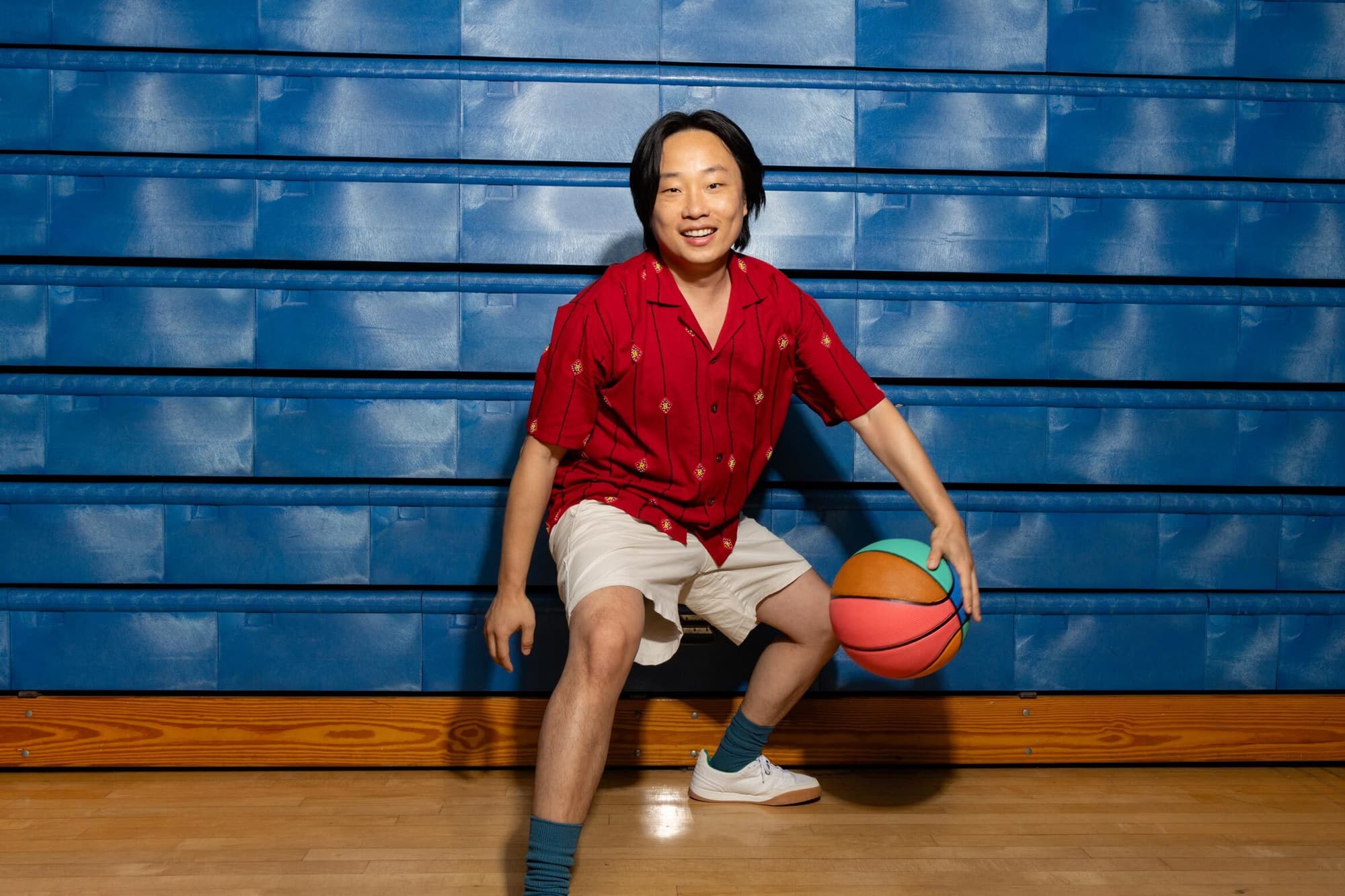Jimmy O. Yang Upgrades His Vision With EVO
Actor and Stand-up Comedian
Actor and Stand-up Comedian

Jimmy O. Yang's Life-Changing Journey with EVO ICL
Jimmy O. Yang, the talented American actor, stand-up comedian, and writer, has always had a passion for entertainment and storytelling. But for years, he faced a common struggle shared by millions worldwide – the hassle of glasses and contact lenses. Discover how EVO Implantable Collamer® Lenses (ICL) changed his vision and his life, highlighting the life-changing benefits of this procedure in his own words.

The Inconvenience of Glasses and Contacts
Jimmy's vision correction journey began when he started wearing glasses at the age of 13. Over the years, the constant need to put on and take off his glasses had become an accepted part of his life. He tried contact lenses during college, but they never truly felt comfortable. For a while, Jimmy resigned himself to the inconveniences of glasses and contacts. Until he discovered EVO implantable lenses, a cutting-edge vision correction procedure that was “a good fit for my eyes and the perfect solution for me.”
The EVO ICL Difference
Jimmy's decision to choose EVO ICL was driven by several remarkable benefits that “made me feel safe with this option”:
- Minimally Invasive Procedure: EVO ICL offers a minimally invasive approach and a safe way to correct nearsightedness, with or without astigmatism.
- Quick Recovery: The procedure's quick recovery time impressed Jimmy, and he was back to his normal activities the next day.
- Effective Vision Correction: EVO ICL provided Jimmy with an excellent quality of vision1,2 without inducing dry eye syndrome3,4.
- Removability and Flexibility: The possibility that a doctor can remove the lenses and/or replace them in the future gave Jimmy peace of mind, knowing he has options.
Since undergoing the EVO ICL procedure, Jimmy's life has been transformed.
“It's made my life much easier. I don't have to worry about the hassle of constantly putting on and taking off my glasses, I can play basketball without worrying about contacts, I can swim and actually see the end of the swimming pool. And now I can finally wear cool sunglasses over my amazing eyeballs.”
In Jimmy's own words, his message to anyone on the fence about getting EVO ICL is simple:
"We're so used to wearing glasses and contacts that we sometimes forget how much of a hassle they are. EVO ICL has made my life much simpler, and if I ever want to throw on an old pair of glasses for looks, I still can, without having to pay for the expensive prescription."
If you're tired of the daily hassles of glasses and contacts, consider following in his footsteps and embrace a future with clear, sharp EVO-vision1,5, just like Jimmy.
References:
1. Martínez-Plaza E, López-Miguel A, López-de la Rosa A, et al. Effect of the EVO+ Visian Phakic Implantable Collamer Lens on Visual Performance and Quality of Vision and Life, Am J Ophthalmol 2021;226:117-125.
2. Parkhurst GD. A prospective comparison of phakic collamer lenses and wavefront-optimized laser-assisted in situ keratomileusis for correction of myopia. Clin Ophthalmol. 2016;10:1209-1215.
3. Ganesh S, Brar S, Pawar A. Matched population comparison of visual outcomes and patient satisfaction between 3 modalities for the correction of low to moderate myopic astigmatism. Clin Ophthalmol. 2017;11:1253-1263.
4. Naves J.S, Carracedo G, Cacho-Babillo I, Diadenosine nucleotid measurements as dry-eye score in patients after LASIK and ICL surgery. Presented at American Society of Cataract and Refractive Surgery (ASCRS) 2012.
5. Packer M. Evaluation of the EVO/EVO+ Sphere and Toric Visian ICL: Six month results from the United States Food and Drug Administration clinical trial. Clinical Ophthalmology. 2022;16:1541-53.

Important Safety Information
EVO & EVO TICL is designed for the correction of moderate to high near-sightedness (-0.5 to -18.0 dioptres (D)) and the reduction of near-sightedness in patients with up to -18 dioptres (D) of near-sightedness with less than or equal to 6.0 dioptres (D) of astigmatism. It is indicated for patients who are 21 to 60 years of age. In order to be sure that your surgeon will use a EVO with the most adequate power for your eye, your near-sightedness should be stable for at least a year before undergoing eye surgery. EVO surgery has been documented to safely and effectively correct near-sightedness between -0.5 dioptres (D) to -18.0 dioptres (D) and partially correct near-sightedness up to -18 dioptres in eyes with up to 6.0(D) of astigmatism. If you have near-sightedness within these ranges, EVO surgery may improve your distance vision without eyeglasses or contact lenses. EVO surgery does not eliminate the need for reading glasses, even if you have never worn them before. The EVO represents an alternative to other refractive surgeries including, laser assisted in situ keratomileusis (LASIK), photorefractive keratectomy (PRK), incisional surgeries, or other means to correct myopia such as contact lenses and eye glasses. EVO is not intended to correct any astigmatism you may have. Implantation of the EVO is a surgical procedure, and as such, carries potentially serious risks. Please discuss the risks with your eye care provider. The following represent potential complications/adverse events reported in conjunction with refractive surgery in general: conjunctival irritation, acute corneal swelling, persistent corneal swelling, endophthalmitis (total eye infection), significant glare and/or halos around lights, hyphaema (blood in the eye), hypopyon (pus in the eye), eye infection, EVO Visian ICL dislocation, macular oedema, non-reactive pupil, pupillary block glaucoma, severe inflammation of the eye, iritis, uveitis, vitreous loss and corneal transplant. Before considering EVO surgery you should have a complete eye examination and talk with your eye care professional about EVO surgery, especially the potential benefits, risks and complications. You should discuss the time needed for healing after surgery.
Important Safety Information
Latin America
संदर्भ
1Visian ICL Patient Information Booklet
2Sanders D. Vukich JA. Comparison of implantable collamer lens (ICL) and laser-assisted in situ keratomileusis (LASIK) for Low Myopia. Cornea. 2006 Dec; 25(10):1139-46.
3Naves, J.S. Carracedo, G. Cacho-Babillo, I. Diadenosine Nucleotid Measurements as Dry-Eye Score in Patients After LASIK and ICL Surgery. Presented at American Society of Cataract and Refractive Surgery (ASCRS) 2012.
4Shoja, MR. Besharati, MR. Dry eye after LASIK for myopia: Incidence and risk factors. European Journal of Ophthalmology. 2007; 17(1): pp. 1-6.
5aLee, Jae Bum et al. Comparison of tear secretion and tear film instability after photorefractive keratectomy and laser in situ keratomileusis. Journal of Cataract & Refractive Surgery , Volume 26 , Issue 9 , 1326 - 1331.
5bParkhurst, G. Psolka, M. Kezirian, G. Phakic intraocular lens implantantion in United States military warfighters: A retrospective analysis of early clinical outcomes of the Visian ICL. J Refract Surg. 2011;27(7):473-481.